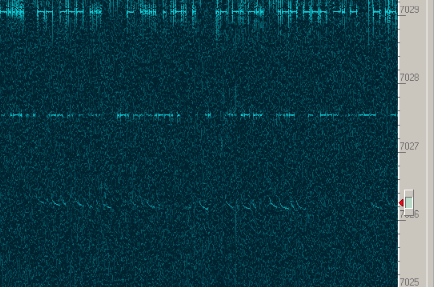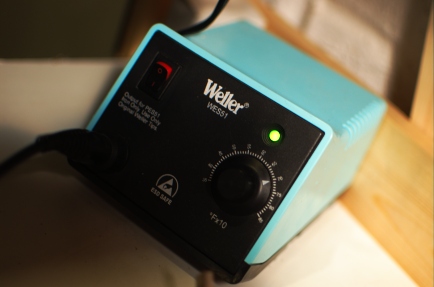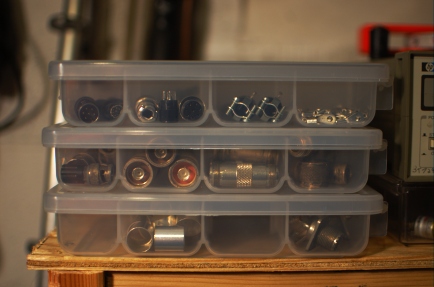Posts Tagged ‘education’
 7-bit Barker Code and Matched Filter
7-bit Barker Code and Matched Filter
Teaching Evan the basics of radar signal processing with this baby-block 7-bit Barker code and its matched filter.
 Ham Radio….It’s really just ham
Ham Radio….It’s really just ham
While the main purpose of this blog is to document my own activities in amateur radio, I do enjoy focusing its attention in an educational manner from time to time. This blog post will be just that…an attempt to provide a little educational value to your reading enjoyment.
If you peruse through amateur radio blogs, amateur radio websites and even amateur radio club websites, newsletters and other publications you will certainly see the term we use to identify our hobby and service written in many ways. Of course the term I’m talking about is the “ham” in ham radio.
Before I go much further (and I do intend to keep this blog posting short), we don’t know a lot about why we are called hams. There are many ideas floating around and most generally agree the true meaning as simply been lost in time. Having said that, the more common idea today is the word may have originally been used to describe a poor operator. This of course was back in those early wireless days when spark was king. This common theory goes on to assume the government, coastal or ship stations may have received interference from early amateur stations and referred to these early amateur stations as hams. It is then believed, not really knowing the word was meant as slang, early amateurs picked it up and began referring to themselves as hams. But remember, this is only a theory.
In todays technical (and not so technical) world we live in we have grown to know many things by an acronym. Just to refresh everyone’s memory. An acronym (credit to Merriam-Webster) is formed from the initial letter or letters of each of the successive parts or major parts of a compound term. An example which most will be familiar with is NATO (North Atlantic Treaty Organization) or FBI (Federal Bureau of Investigations) or how about ABC, NBC and BBC. The acronym (regardless of the number of letters/words) is written and referred to by those letters typically written in upper case.
As I stated, these acronyms are all around us. In my day job, I have to be very careful when I am presenting or teaching to not get carried away with throwing out acronyms as I shouldn’t assume everyone understands their meanings when I start speaking about FAQ, VPN, VoIP, TCP, CRM and ERP.
In the amateur radio hobby we use many acronyms to describe various components of our hobby and service. Some that come to mind are FCC, ARRL, RSGB, SSB, SSTV, PSK, RTTY, VHF, UHF, HF, CRT, LCD, LED, EME, CMOS and MOSFET. I’ll stop there as you get the idea.
The take away and educational point I’m driving home is the word “ham” in ham radio is not an acronym. Simply put, the word is just a word which follows the laws of regular sentence structure. Since it is not an acronym, it’s not necessary to capitalize each letter (e.g. HAM) it is also not necessary to place a period or dot between each letter (e.g. H.A.M.). If you are writing ham radio in a sentence it just follows all the normal rules. Ham would be capitalized if starting a sentence. If not, ham would just be written in lowercase. That really is it.
Of course, nothing bad will happen if you choose not to follow this guidance. But in my opinion, (and others agree) writing it as an acronym or going outside of the rules of normal sentence structure is not correct. This just leads to new hams becoming confused and of course teaching something which just simply isn’t true. The issue just perpetuates itself on down the road. To go back to Merriam-Webster, “perpetuates means to make something, (typically an undesirable situation or an unfounded belief) continue indefinitely.
Until next time….
73 de KD0BIK (Jerry)
 Extra, Extra, Extra…Read all about it!
Extra, Extra, Extra…Read all about it!
 I realize it was just Wednesday, 24 August when I blogged about reaching the 50% mark in the amateur extra training course I’ve been attending. I also realize it’s been less than a month (21 days to be exact) since I blogged about getting serious about extra….Again!! I have some great news I’ll share with you all in just a minute.
I realize it was just Wednesday, 24 August when I blogged about reaching the 50% mark in the amateur extra training course I’ve been attending. I also realize it’s been less than a month (21 days to be exact) since I blogged about getting serious about extra….Again!! I have some great news I’ll share with you all in just a minute.
When I first got my license in August 2007, I knew I wanted to upgrade to the general class and I wanted to do it in relatively short time. I will admit that I quickly grew bored with working local VHF/UHF repeaters and while I did manage to work 10m HF, the QSO’s made on that band were few and far between. I became intrigued in PSK31 after watching Randy Hall’s K7AGE Youtube videos. Within a few weeks of earning my technician license, I was actively reading and preparing for general. I tested for my general ticket on 5 January 2008, just four months after getting my ticket.
Something else I need to admit is once I had my general in hand, I was satisfied. I had all the HF privileges that I believed I needed and wanted. I was happy as a pig in mud with being able to work PSK31, RTTY and of course phone on all the bands generals have access to. I even remember a conversation with a colleague from my office who was also a general. We both discussed how general was all we felt we would ever need.
Now keep in mind this was inside of my first six months of the hobby. In May of 2008 I started the Practical Amateur Radio Podcast and the Elmer bug bit me. Also, it was through the podcast and social media sites like Facebook and Twitter where I really became friends with many hams who were either already extra class or working to become extra class.
I believe it was very soon after I started the podcast and really started to get more involved with my Elmer activities that I realized I did see more to the hobby than staying at general. Sometime during the summer of 2008 I picked up the ARRL extra class study guide and started reading. But sadly over the last three years the ARRL extra class study guide spent more time on the shelf than it did in my hands.
Now jump forward three years and as I blogged on 8 August, I had once again pulled the book from the shelf and began studying. The approx. 50% of the material I had previously read all came back to me relatively easy. Plus the SCARS Echolink training was adding additional knowledge and confidence to my overall process. Again, just as I blogged last Wednesday, I truly felt on-track to take the exam in late September or early October. While I didn’t state this in writing, my unofficial target date was prior to October 4. On October 4 I turn 45 years old. Birthday present to myself???
On Thursday (just one day after the blog update) I had been passing the sample tests from QRZ in the high 80’s to low 90 range. My ideal practice score is in the upper 90’s as I don’t feel I am the best at taking exams. I told my wife that I couldn’t see a reason for me to delay taking the exam and she supported my decision to take a chance. She actually suggested I go into the exam thinking it was just another practice exam. If I didn’t pass, I still had several weeks of the SCARS class to continue to build my understanding of the material (this has always been my #1 goal versus memorization). Another reason to give it a try is my schedule at work is also starting to pickup speed again. I was recently promoted and had a few added responsibilities sent my way. I feared if I delayed, something would happen and I would lose the momentum.
I went to bed on Friday night feeling pretty nervous, but feeling confident. I slept remarkably well and woke up with enough time to enjoy some coffee and a bagel and just ease into the morning. I didn’t take any sample tests…I just enjoyed the peacefulness of the morning. With a cup of coffee for the road (a roadie) I started the 25 mile journey to Franktown, Colorado for the Colorado ARES sponsored VE session. By 9:45 AM, I had the CSCE in my hand and had finally made extra.
In closing, I don’t view the extra class as the only true ham class. For those who are technician, general, advanced….if you are happy then this is what matters. You are just as much a part of this hobby and service as anyone else is. However, if you are interested in upgrading I say go for it. I’m glad I finally got serious about it and followed through….ALL THE WAY through.
Finally, thanks to all who over the past several weeks have taken the time to post comments to the blog and even email me to lend words of encouragement. This meant a lot to my study and preparation process. I felt like I had all of you with me yesterday cheering me on as I worked through the 50 questions and answers.
Until next time….
73 de KD0BIK/AE
 Fascinating signals: AA1TJ/QRPp
Fascinating signals: AA1TJ/QRPp
Last night, as I have been doing lately in both the evenings and mornings, I was trawling the bands with a SoftRock (a dual-band v6.0 built for 40 and 80 meters—my first SoftRock) and Rocky. Without fail, the waterfall enables me to see something interesting, which brings me to the point that I really need to integrate these receivers into my station. But, I digress. The really tantalizing, fascinating signals are the weak ones, especially when they are weak and unusual.
The subject weak and unusual signal is shown in the figure headlining this post. Rocky’s cursor shows the approximate bandwidth of the CW filter (250 Hz, if I recall correctly) and the center frequency (7026.25 MHz). I tuned it in and caught a CQ from “AA1T…” Recalling that I head read about Mike, AA1TJ‘s, Das DereLicht transmitter built mostly from parts scavenged from a dead CFL, I suspected it was him. After a moment the QSB came up and I caught the ‘J.’ Thanks to the fact that the SDR is not fully integrated into the station, I scrambled to plug my 15-year-old Small Wonder SW-40 in and get it online. Mid-scramble, Sarah handed Evan off to me for a diaper change, but I did manage to snap the screenshot above. By the time I returned to the shack awhile later to close things down, AA1TJ had disappeared.
Through the (ubiquitous) magic of the Internet, I sent Mike an apologetic e-mail QSL, which yielded a nice response. It turns out that he was trying a 40-meter version of the first transistor transmitter described in the amateur literature. The design for 146 MHz by K2AH appears in March 1953 QST. If you are an ARRL member, pull up those old QSTs in the archives and read about it. K2AH is on the cover of February 1953 QST with the same transmitter. Mike figures he was making 20 mW, or 20650 miles/Watt on the path from his station to mine. The more remarkable thing is that he was using a 1956-era point-contact transistor (the same type as in the K2AH article). Fascinating stuff! Hopefully, we’ll connect for a real over-the-air QSO sometime soon.
Thanks, Mike, for making my day by doing something interesting and sharing it on the air!
 Getting serious about extra…Again!
Getting serious about extra…Again!
I have been thinking about, reading and studying for my US amateur radio extra class license now since early 2008. If you are new to my blog and do not know me through my podcast or the various social media locations I hang out on, then you might not know that I originally got my license in August of 2007 and upgraded to general in January of 2008. For much the same reason it it best for a graduating high school senior to start his/her college studies the very next fall (after graduation) the same can be said for the amateur radio exam and study process. Once you are in the mode of studying and testing, it is much easier to just to keep moving along the process.
Of course I didn’t take my own advice and I have on more than one, two and perhaps more than three occasions picked up the ARRL Extra Class license manual and said today is the day I start (or start over again). Sadly, Yes…it has been “start over” since too much time had passed from the last time I seriously studied and read the material.
I recently heard about an amateur extra class starting up online. The class is hosted by the South Coast Amateur Radio Service (SOUTHCARS) and is taught by extra class operators and all done on-line using Echolink or IRLP. The time commitment is twice per week (Sunday and Tuesday evenings) and is scheduled to complete by middle of September.
I’m really not going to pressure myself or make commitments to anyone that this time will be different. I’m also not (at this moment) setting myself any hard and fast deadlines for when I would attempt an exam session after the middle of September. I’ve made these mistakes before and honestly, it’s been one of the reasons I’ve put the book back on the shelf.
All I can do is make an attempt to attend each of the twice weekly sessions and follow the guidance of the instructor(s). I think the one key difference I see in this plan is the training class only lasts a little over one month. It’s not something that is going to string out for half the year. Fingers crossed, my work schedule will comfortably allow this and I can get through the class and on the other side be better prepared (both knowledge wise and confidence) to take the exam. I won’t lie about this….my biggest fear is sitting for the extra class exam and failing. I know failing is not the end of the world, but just a hard thing for me to deal with.
Well….while I wasn’t going to post a blog post today, I did want to get this out there. Wish me luck.
Until next time,
73 de KD0BIK
 The Joy of Homebrew
The Joy of Homebrew
This is about building electronics, not making beer, at home; although, I am sure there are parallels. Three things brought me to writing this: 1. an eHam forum thread I responded to a few weeks ago; 2. the June 2011 issue of IEEE Microwave magazine (has articles by K2UYH, N2UO, and KK7B, perhaps others? thanks to W3KL via the PVRC reflector for bringing it to my attention since I let my IEEE/MTT membership lapse); and 3. a few minutes spent last night resuming a partially-completed Softrock kit gifted to me by a friend who decided to buy a FLEX-3000 instead.
Every once in a while, a thread appears on an amateur radio forum that goes a little bit like this, “Hi, I’m a new ham and I don’t have a lot of money to spend so I want to build an HF SSB station from scratch” or something similar. Somehow, somewhere, somebody has given the impression that it is less expensive to build your own amateur radio equipment than to buy it. That’s true in some circumstances, but certainly rarely for anything that is mature, mass-produced, and readily-available on the second-hand market. After all, there is nothing novel about a 100-watt superheterodyne HF SSB transceiver these days. The principal uncounted cost is the “engineering cost” associated with getting your first few projects working and keeping them working.
One of the first construction projects I undertook as a new ham was to build a Ramsey Electronics HR-20 (NE602-based) 20-meter receiver—$20 at a hamfest. It did actually work eventually—but this was a simple kit with maybe two dozen parts. Next, I built a ONER transmitter kit from now defunct 624 Kits. I think that was another $20. I never made any QSOs with that combination because I was always afraid of blowing out the receiver with the transmitter. The first thing that I built that I actually managed to make a QSO with was a Small Wonder Labs SW-40, which I still have. That set me back $55 and it did not work immediately. Suddenly, that’s over $100 by the time you include the money I spent on a soldering iron and solder. That’s one-third to half-way to a “real” used HF transceiver and I had two bands at 1 watt on CW only. Furthermore—these are all kits—they leverage economies of scale in purchasing parts from various vendors and they have instructions to help you along. And, I’d like to think that I was a relatively representative example of a recently-minted ham who had more ambition than money or skills…
As I soldered down 1206-size (easy ones) SMT capacitors last night, I was thinking of times that I rushed through a homebrew or kit project just to get it on the air. In those instances the process was often, as I have belabored above, about saving money, not about the act of creating something. Last night was about creating, not saving, and that is the joy of homebrew.
 Marrying the TI-85 and the DJ-580T
Marrying the TI-85 and the DJ-580T
The May issue of QST arrived in the mail today and an article about building a “fox” for hidden-transmitter hunting was included. That brought back memories of a teenage project of mine that I had once thought of writing up for QST, but now just makes a good story for the blog.
The first (and only) handheld radio I’ve owned is an Alinco DJ-580T. Like most HTs of a certain age, it has provision for an external (“speaker”) microphone. The microphone input is a sub-miniature (3/32-inch, “2.5 mm”) stereo phone plug. As a high school student, one of my passions was tinkering with a graphing calculator—the venerable Texas Instruments TI-85—do kids these days even use this stuff or have they gone the way of slide rules and nomograms? The TI-85 offered the provision to link to a computer or another calculator through a similar sub-miniature stereo phone plug.
Well, one afternoon in probably 1997, I was sitting with the DJ-580T in one hand and the TI-85 in the other…and it hit me…I wonder if I can use the the TI-85 to drive the DJ-580T microphone input?
A few preliminaries are now in order. Thanks to a helpful (and still operational, albeit now with a CMS and the attendant spam) web site called ticalc.org, a few friends and I had learned to load our TI-85s with third-party binary machine code programs with considerably faster execution times than the built-in scripting language. This allowed us to play relatively powerful video games surreptitiously on a school-sanctioned platform…a tactic that worked well until the English teacher wisened up to the fact that the five students with their calculators out were not typing essays on them. Not satisfied to just play games—although I did set a very high score in Tetris during Spanish class—I sought to harness the power of the Z80 microprocessor in the TI-85 for myself. Recall that this was before widely-available and inexpensive microcontroller development systems like the PIC, Arduino, and AVR.
I gathered the tools and eventually managed to write some fairly sophisticated (given my utter lack of formal training in computing) software in Z80 assembly language, including a crude clone of Space Invaders and a crude adventure game I called “Kashmir.” Maybe some screenshots or stories about them will come later.
But, for the story at hand, I learned how to manipulate the link port. Fortunately, the sleeve was ground on both the TI-85 and the DJ-580T. So, it was just a matter of tip and ring—one was audio and the other was PTT on the radio, and both were settable on the TI-85 for some kind of two-wire communication link. So, I reasoned that I could write up a bit of assembly code that would key the PTT by pulling it low, then toggle the audio line back and forth at 500 Hz or so to generate a rough audio tone. It worked!
This was an expensive, although trivially so since I had the hardware, way to build a hidden transmitter. So, I modified the software to send my callsign in Morse code (using a look-up table) and stuffed the whole thing in a cigar box. It was good fun for a few of us teenage boys.
And, for the interested, I found the original source code, which is sadly not well commented or dated. But, it does have my old callsign (AA8UP) listed by the lookup table.


















